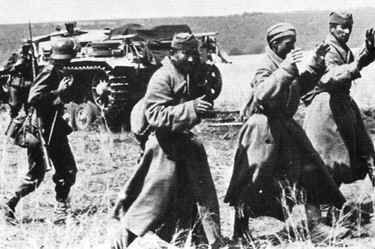The Kharkov Offensives took place in 1942. Kharkov was in south-west Russia and the Russian attempt to win back the city was to counter Hitler’s plan to conquer south-west Russia and move on to the Middle East oil fields.
 |
By the summer of 1942, the Red Army had fought itself to a standstill in a series of major offensives against the Germans. Stalin had expected the Allies to launch a second front against the Germans in France, but to his exasperation the Red Army, in his mind, seemed to be fighting the whole might of the Wehrmacht. Stalin had identified what he believed were certain major targets in the region and the most important target of all was Kharkov. Though the Red Army had defeated the Wehrmacht at Moscow, the Germans still had about 70 divisions near the capital which continued to pose a major threat.
The Red Army had been on the offensive during the winter of 1941–42. By the end of this offensive, the Russians had re-captured what was known as the Barvenkovo Salient, south of Kharkov.
In the spring of 1942, there was a brief lull in fighting. However, the fighting soon started again in earnest. Stalin had made plans for a major offensive against the Germans in the region. The Germans were also preparing for a major offensive against Russian forces in the area so that the southern ‘arm’ of Barbarossa could be attained.
The Russian victory at Moscow had filled many in the Red Army with confidence. This feeling was also shared by Churchill who wrote to Stalin that he was extremely confident about the outcome of the campaign in Russia. Roosevelt had also expressed his belief that the war in Russia would be over by the end of the year.
By the spring of 1942, Russia’s seemed to have made a recovery from the onslaught of Barbarossa. The transfer of industry east had allowed the Russians time to reorganise and modernise her military. In view of the importance that mechanised warfare was going to play on the Eastern Front, the development of the legendary T34 was crucial to the Red Army.
By May 1942, the Red Army stood at 5.5 million men, 5,000 tanks, 41,000 artillery guns and mortars supported by about 2,500 combat planes. Though the figures may have been impressive, the quality of much of this equipment left a lot to be desired as most had yet to be replaced by modern equipment.
In comparison, the Wehrmacht had 6.2 million in the same front, 57,000 artillery guns and mortars, 3,200 tanks and 3,400 combat aircraft. A great deal of this equipment was modern and proven in battle.
The weakness of the Red Army had been shown when its offensive against the Germans had petered out in March 1942. The Red Army ran out of supplies – especially ammunition, and when compared to the Germans, seemed under-equipped.
Hitler had already made it clear to a Japanese diplomat what his intentions were. He had said in January 1942, that he expected another massive attack on the Caucasus so that the military would reach the oil supplies of Iraq and Iran. Hitler’s views were shared by Foreign Minister Ribbentrop.
On March 15th, 1942, Hitler said in public:
| “The Soviets will be defeated this summer; there is no salvation for them anymore. Therefore, the summer will be the decisive stage of the military operations. The Bolsheviks will be thrown back so far that they will no longer tread on the cultivated soil of Europe.” |
After the war, Field Marshall Keitel, during his interrogation, described the logic behind the plan:
| “The aim of the offensive: to remove the Donbass completely from Russia’s military-economic balance, to cut off the transport of oil along the Volga, and to seize the main oil supply bases, which according to our estimates, were in Maikop and Grozny.” |
The only measure of whether a German attack in the south-east was successful was whether the Germans got to the oil fields that its military so desperately needed.
On May 8th, 1942, the Germans launched a massive assault against the Crimean Front. Four days later the Russians launched an offensive in an effort to break out of the Barvenkovo Salient (south of Kharkov). Here a large army group was trapped on three sides. The Germans were planning to attack this salient from the south via an attack by the XVII Army and the 1st Panzer Army. In an effort to get out of the salient, the Russians launched their own offensive north towards Kharkov. The initial phase of this battle went well for the Russians but they failed to maintain their momentum.
By May 15th, the German VI Army had contained this offensive and two days after this, the Germans launched a major counter-offensive which cut off the Barvenkovo Salient from the Russian South-West Front.
By the end of May, the Russians attempt to re-take Kharkov had failed as had their attempt to get out of the salient. The Red Army lost many men and equipment in this campaign. Just days later the Germans launched its attack on Sebastopol.